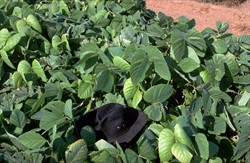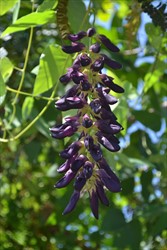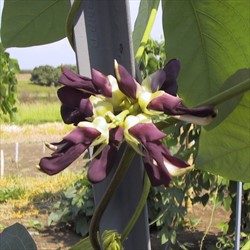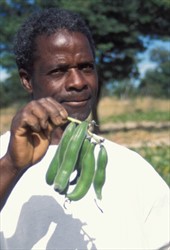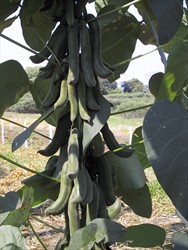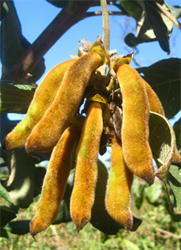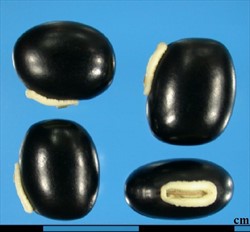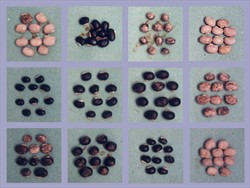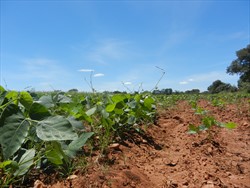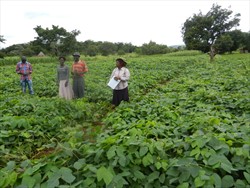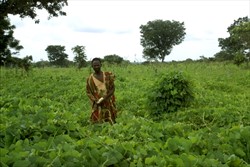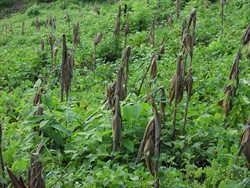Mucuna pruriens
Tropical Forages
Mucuna pruriens (L.) DC.
Subordinate taxa:
Mucuna pruriens (L.) DC. var. hirsuta (Wight & Arn.) Wilmot-Dear
Mucuna pruriens (L.) DC. var. pruriens
Mucuna pruriens (L.) DC. var. sericophylla (Perkins) Wilmot-Dear
Mucuna pruriens (L.) DC. var. utilis (Wall. ex Wight) Baker ex Burck
Note: This fact sheet focuses only on the commonly cultivated var. utilis.
Basionym: Mucuna utilis Wall. ex Wight; Carpopogon capitatus Roxb.; Carpopogon niveus Roxb.; Macranthus cochinchinensis Lour.; Mucuna aterrima (Piper & Tracy) Holland; Mucuna capitata (Roxb.) Wight & Arn.; Mucuna cochinchinensis (Lour.) A. Chev.; Mucuna deeringiana (Bort) Merr.; Mucuna pachylobia (Piper & Tracy) Rock; Mucuna pruriens var. biflora Trimen; Mucuna velutina Hassk.; Stizolobium aterrimum Piper & Tracy; Stizolobium capitatum (Roxb.) Kuntze; Stizolobium cinereum Piper & Tracy; Stizolobium deeringianum Bort:; Stizolobium hassjoo Piper & Tracy; Stizolobium microspermum Piper; Stizolobium niveum (Roxb.) Kuntze; Stizolobium pachylobium Piper & Tracy; Stizolobium pruritum subsp. maculatum Piper; Stizolobium pruritum subsp. officinale Piper; Stizolobium pruritum var. biflorum (Trimen) Piper; Stizolobium utile (Wall. ex Wight) Piper & Tracy; Stizolobium velutinum (Hassk.) Piper & Tracy
Family: Fabaceae (alt. Leguminosae) subfamily: Faboideae tribe: Phaseoleae subtribe: Erythrininae.
Vigorous annual (sometimes biennial), twining herb, stems extending to 18 m in length. Leaves trifoliolate; lateral leaflets 7–15 (–19) cm long, 5–12 cm wide, conspicuously asymmetrical, the abaxial side larger than the adaxial side; terminal leaflet elliptic or ovate-rhombic, (3–) 14–16 cm long, (4.5–) 8–10 cm wide, symmetrical, base broadly cuneate to rounded, apex rounded, acute, or shortly acuminate, somewhat smaller. Inflorescence a many-flowered, pendulous axillary raceme 15–35 cm long; flowers white, mauve or dark purple; standard 1.6–2.5 cm, ½– ⅔ of keel length; wings 2–4 × ca. 1.2 cm, shorter than or subequal to keel; keel 2.8–4.2 (–4.5) cm. Pods oblong, 4–13 cm long, 1–2 cm wide, usually more or less sigmoid in shape, finely pubescent with white to light brown hairs. Pods contain up to 7 oblong-ellipsoid seeds, 1–1.9 cm long, 0.8–1.3 cm wide, 4–6.5 mm thick and of variable colour (black, maroon, creamy, white, grey, beige, brown, and mottled), hilum surrounded by a prominent, cream-coloured aril. 1,200– 1,800 seeds per kg
var. utilis: Fruit with long pale silky hairs (no irritant bristles), often misshapen, irregularly swollen around seeds; seeds often mottled or streaked in different colours; terminal leaflet broad, length less than or to 1.5 × width, lateral leaflets often much larger than terminal; calyx without irritant bristles.
var. pruriens: Fruit with orange or brown irritant bristles; seeds uniform in colour; terminal leaflet with length 1.5–1.75 × width, lateral leaflets of similar size; calyx often with irritant bristles containing mucanain (a cysteine protease) and serotonin (a neurotransmitter).
Africa: chitedze (Malawi); upupu (East Africa, Kiswahili); nkasi, sepe (Zambia); feijão maluco (Angola and Mozambique); huriri (Zimbabwe); agbala, akpakru, lyekpe, devil's beans (Nigeria); eesin, ejokun, esinsin, esise, irepe, werepe, yerebe (wider West Africa)
Asia: 刺毛黧豆 ci mao li dou (China); tam nhè (Laos); kacang babi, kacang gatal, kekara gatal, kara-kara gatal, kramé, naykuruna (Malay); khway hlay ya (Myanmar); หมามย ma mui (măa mûi), หมามุ่ย ฝักงอน (măa mûi fàk ngon), ma yueang (Thailand); dây sắn, đậu mèo, đậu mèo rừng, dây sắn, đậu ngứa, đậu mèo lông bạc, ma niêu, mắc mèo (Vietnam)
English: Bengal velvet bean, cowage velvet bean, Florida velvet bean, lacuna velvet bean, Lyon velvet bean, Mauritius velvet bean, velvet bean, Yokohama velvet bean; cowitch, monkey tamarind (Jamaica and Barbados)
Europe: pois a gratter, pois pouilleux, pois velu (French); Juckbohne (German); stizolobia (Italian)
Indian subcontinent: bandar kekowa (Assamese); akolchi (Bengali); kavach (Gujarati); bhainswalibel, gaunch, goncha, जाङ्गली jangali, जड़ा jara, kaunch, कवाांच kavanch, kevanch, kevatch, kivach, ककवाांच kiwanch, कोंच konch (Hindi); nayisonanguballi (Kannada); naicorna (Malayalam); kauchho, खाज कुइरी khaj-kuiri (Marathi); काउसो kauso (Nepali), wandhura mae (Sinhalese); punaippidukkan (Tamil); pilliadugu (Telugu)
Latin America: café de Mato Grosso, fava-de-café, fava coceira, feijão-café, feijão inglés, feijão mascate, mucuna rayada, olhos de burrico, olhos de burro, veludo (Brazil); cádjuet, chiporozo, chiporro, cidjuer, fogarete, frijol aterciopelado, frijol de abono, frijol de terciopelo, guisante negro, haba terciopelo, habichuela, ojo de buey, ojo de samuro, ojo de venado, ojo de zamuro, pica pica (Spanish)
Native:
Africa: Angola, Burundi, Cameroon, Central African Republic, Chad, DRC, Equatorial Guinea, Ethiopia, Ghana, Guinea, Guinea-Bissau, Kenya, Liberia, Malawi, Nigeria, São Tomé and Principe, Senegal, Sierra Leone, Somalia, South Africa (KwaZulu-Natal, Transvaal), Sudan, Tanzania, Togo, Uganda, Zambia, Zimbabwe
Indian Ocean: Madagascar
Asia: Bangladesh, Bhutan, Cambodia, China, India, Indonesia, Malaysia, Myanmar, Nepal, Philippines, Sri Lanka, Thailand, Vietnam
Papuasia: Papua New Guinea
Indigineity of Mucuna pruriens is uncertain. While many sources claim it most likely originated in India and south-eastern Asia, including southern China, others, including GRIN, believe it has broader origins.
Cultivated:
Widely cultivated across the tropics.
Forage
Velvet bean is primarily used as a green manure, but also as cut-and-carry forage, ands can be conserved as silage and hay. The seeds can be used as concentrate feed. It has been successful in cut-and-carry systems in eastern and southern Africa (e.g. Uganda, Malawi and Zimbabwe), and usage is rapidly increasing.
Environment
Green manure, fallow and cover crop. Widely used in cotton farming systems in southern USA in at least the first early half of the 20th century. Used to control Imperata cylindrica in Benin and Vietnam. In central America it is used in fallow rotations where Mucuna is relay-sown 45 days after maize.
Other
M. pruriens has numerous medicinal applications in both traditional medicine and modern pharmacology. The seeds contain the amino-acid L-dopa which has been linked to improvements in nervous systems disorders including Parkinson’s disease and in the treatment of scorpion bites and in providing a protective effect against snakebite in India (and Nigeria). It is used occasionally as minor crop for human consumption (roasted beans are used as a coffee substitute and cooked immature beans and young leaves as vegetables).
Soil requirements
M. pruriens can be grown successfully on soils ranging in texture from sands to clays, as long as they are well-drained. While it prefers soils of medium to high fertility, it tolerates and can be productive in fairly infertile soils over a very wide soil acidity range (pH <5.0–8.0).
Moisture
Prefers hot, humid climates with annual rainfall of 1,000–2,500 mm, but will grow in environments with annual rainfall as low as 400 mm. Has some tolerance of drought but is not tolerant of waterlogging.
Temperature
Is susceptible to frost but, because of its relatively short life span and rapid growth, it can be grown in the subtropics. Performs best at altitudes from 0 to 1,600 m, but can be grown up to 2,100 m asl. For grain production, altitudes of 1,200–1,500 m asl are best. Optimum temperature range is 19–27 ºC.
Light
Requires high light intensity.
Reproductive development
Responds to shorter day lengths, flowering being also stimulated by higher (21 ºC) night temperatures. Period between flowering and mature seed is long, with pods starting to ripen 2–3 months after flowering. Mucuna usually dies off 45–60 days after producing seed.
Defoliation
Some regrowth is possible if plants are cut before flowering.
Fire
No information available.
Guidelines for establishment and management of sown forages.
Establishment
Does not require a high degree of land preparation. Best results are with drilling with an arrangement of about 1 m between rows and 20–80 cm between plants (20–40 kg/ha seed); seeds are large and so seeding depth can be as deep as 10 cm but mostly 3–7 cm. Seed does not require scarification or inoculation with rhizobia prior to planting.
Fertilizer
Despite its ability to grow on soils with low available soil P, Mucuna responds to phosphorus applications. There are also reports of responses to applications of lime on acid soils either from amelioration of pH or from Mg and Ca applications.
Compatibility (with other species)
Velvet bean is very vigorous and its growth suppresses companion species. If grown in interrow cropping systems, it should be sown well after the other crop such as maize, as much as 45 days after, to overcome this competition. Sowing two weeks after maize results in a good mix for silage.
Companion species
See above.
Pests and diseases
Few problems with insect pests, likely due to toxic compounds.
Ability to spread
Little information available but there is no evidence of velvet bean spreading aggressively into non-cultivated areas.
Weed potential
Can become weedy in cultivation if seed is left to mature in situ but this outcome would be rare.
Nutritive value
Depending on stage of maturity, CP in foliage DM 11–23%, and 20–35% in the grain. High mineral, i.e. K, Mg, Ca and Fe, and lysine contents in grain. Digestibility of foliage 60–65%, grain >95% and husks 78%.
Palatability/acceptability
Although there are reports of low palatability, there are others suggesting that velvet bean areas need to be well fenced to avoid grazing by untethered animals.
Toxicity
Because of a range of anti-nutritive substances, untreated Mucuna grains can be toxic for human and non-ruminant animal consumption. The most important toxic compounds are the non-protein amino acids L-dopa (content in seeds <2% to >7%) and hallucinogenic tryptamines. Furthermore, trypsin-inhibiting activities have been detected in the seed. Grain treatment has best been done by boiling in water for one hour, pressure-cooking for 20 minutes, or boiling in water for 30 minutes after soaking in water for 48 hours. Despite the presence of anti-nutritional compounds however, there is evidence that velvet bean grains can be fed to ruminant animals to supplement their diet without apparent problems.
Feedipedia link
Dry matter
Mucuna has high DM production. Yields range from 5 to 12 t/ha depending on rainfall. Yields in Malawi can be expected to reach 9 t/ha and similar yields in a 900 mm rainfall region of Zimbabwe. Similar yields have been reported from Nigeria and Uganda. Mucuna can produce high yields even in soils with marginal or even low available phosphorus.
Animal production
Tried mainly for protein supplementation in bovines, sheep and goats. As an example, a daily liveweight gain of 60 g/animal compared with 44 g with commercial concentrates has been obtained with sheep. Also, velvet bean hay has been successfully substituted for dairy concentrates in Zimbabwe without decline in milk yield or quality and has been recommended for this purpose. Response of monogastrics varies in literature.
2n = 22 (20, 24). Self-pollinating.
Varieties mature in 100–280 days after start of flowering. Maturation is not uniform. High levels of grain production are possible (0.2–2.0 t/ha). Plants need support because of the size and weight of pods.
No information available.
- Fast growing.
- Seed easy to produce (few pests, easy to harvest, good yields).
- Ease of establishment: large seed; does not need complete land preparation and covers the soil quickly.
- Improves soil fertility.
- Resistance to pests and diseases.
- High potential to rehabilitate weed-infested land (Imperata cylindrica).
- High digestibility, CP and mineral contents.
- Can be used to make high quality hay and concentrate feed (seeds).
- Presence of L-Dopa and other toxic and anti-nutritive compounds in seed. Use as food and feed for monogastrics is problematic.
- Low palatability of foliage.
- Limited drought tolerance.
- Lacks adaptation to very acid, low fertility soils .
- In Central America, Mucuna is reported not to suppress the grass weed Rottboellia cochinchinensis but rather to strengthen Rottboellia populations
.
Buckles, D. (1995) Velvetbean: a "new" plant with a history. Economic Botany 49:13–25. doi.org/10.1007/BF02862271
Buckles, D., Triomphe, B. and Sain, G. (1998) Cover crops in hillside agriculture. Farmer innovation with Mucuna. IDRC and CIMMYT, Ottawa, Canada. hdl.handle.net/10883/965
Capo-Chichi, L.J., Weaver, D.B. and Morton, C.M. (2001) AFLP assessment of genetic variability among velvetbean (Mucuna sp.) accessions. Theoretical and Applied Genetics 103:1180–1188. doi.org/10.1007/s001220100722
Carsky, R.J., Tarawali, G., Becker, M., Chikoye, D., Tian, G. and Sanginga, N. (1998) Mucuna – herbaceous cover legume with potential for multiple uses. Resource and Crop Management Research Monograph No. 25. International Institute of Tropical Agriculture (IITA), Ibadan, Nigeria. hdl.handle.net/10568/95971
Eilittä, M., Muinga, J., Mureithi, R., Sandoval, C. and Szabo, N. (2003) Increasing Mucuna’s potential as a food and feed crop. Proceedings of an international workshop, Mombasa, Kenya, September 23–26, 2002.
Masikati, P., Manschadi, A., van Rooyen, A. and Hargraves, J. (2013) Maize-mucuna rotation: An alternative technology to improve water productivity in smallholder farming systems. Agricultural Systems 123:62–70. doi.org/10.1016/j.agsy.2013.09.003
Piper C.V. and Morse, W.J. (1922) The Velvetbean. Farmers Bulletin No. 1276. U.S. Department of Agriculture, Washington, DC, USA. bit.ly/2JnGzhT
Qi, A., Ellis, R.H., Keatinge, J.D.H., Wheeler, T.R., Tarawali, S.A. and Summerfield, R.J. (1999) Differences in the effects of temperature and photoperiod on progress to flowering among diverse Mucuna spp. Journal of Agronomy and Crop Science 182(4):249–258. doi.org/10.1046/j.1439-037x.1999.00308.x
Whitbread, A.M., Jiri, O. and Maarsdorp, B. (2004) The effect of managing improved fallows of Mucuna pruriens on maize production and soil carbon and nitrogen dynamics in sub-humnid Zimbabwe. Nutrient Cycling in Agroecosystems 69:59–71. doi.org/10.1023/B:FRES.0000025291.62043.11
Wulijarni-Soetjipto, N. and Maligalig, R.F. (1997) Mucuna pruriens (L.) DC. cv. group Utilis. In: Faridah Hanum, I. and van der Maesen, L.J.G. (eds) Plant Resources of South-East Asia No. 11. Auxiliary Plants. Backhuys Publishers, Leiden, the Netherlands. p. 199‒203. edepot.wur.nl/411331
No forage cultivars appear to have been formally released anywhere. The ecotypes being used in Africa and elsewhere appear to be selections made some decade ago and trialled and used as forages and green manure since.
Piper and Morse (1938) make reference to "Florida", "Georgia", "Alabama", "Arlington", "Lyon", "Osceola", "Yokohama" and "Georgia Bush" velvetbean ecotyypes (whch appear to differ mostly in days-to-maturity). Most of these appear to be direct introductions into the USA. The ecotypes in some cases align with the species names given to them by Piper (see Synonomy). The variety "Georgia Bush" was developed from a single plant by Roan Beaseley at Kite, Georgia, USA. This cultivar was described as being bushy, and used in orchards and is the "cultivar" used in a number of more recent research programs in southern USA.
None reported but clearly the ecotypes being succesfuly used in parts of Africa and India are "promising" as are the various ecotypes described by Piper and Morse (1938).
